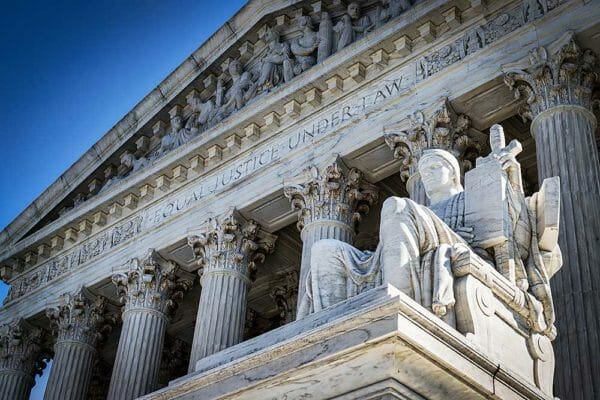Opinion

New York – -(AmmoLand.com)- When recounting the import of U.S. Supreme Court case holdings, especially pertaining to our Nation’s fundamental rights and liberties—the most important of which is codified in the Second Amendment of the Bill of Rights—one must be reminded that the Third Branch of Government is not a distant poor cousin of the other two, and is not to be treated as if it were such.
Yet, it is often denigrated as such, especially when some case decisions, like those in the recent Bruen and Dobbs cases, happen to throw some people into a fit of rage, threatening the Court and threatening the life of some Justices within it, and threatening the viability and “legitimacy” of the High Court.
And legal scholars get in on the act. One such scholar, Barry P. McDonald, a Law Professor at Pepperdine University, argues the founding fathers had intended to relegate the Supreme Court to second-class status.
If true, the impact of that inference has dangerous repercussions for the people’s right to check the power of that Government through force of arms.
McDonald’s essay was published as an Op-Ed in the NY Times, a few days after the Senate voted to confirm Brett Kavanaugh as an Associate U.S. Supreme Court Justice.
Obviously, Professor McDonald disapproved of the confirmation, no less so than The New York Times that sought McDonald out as a credentialed college professor to give weight to its own abhorrence of the Court and of the confirmation of Kavanaugh to sit on it as an Associate Justice.
The three Branches of the Federal Government, even in their infancy, had started to jockey for power. Even so, usurpation of power is contrary to the dictates of the Constitution which delineates the powers and authority of each Branch, thereby establishing the parameters for the exercise of powers so delineated for each Branch. No Branch is permitted to transgress the Constitutional boundaries of power set for it.
Had the framers of the Constitution sought to place the High Court under the auspices of another Branch as in the English Parliamentary System, the framers would have plainly provided for that. They did not.
There were many possible Governmental forms and many permutations within any Governmental form to choose from. The framers of the Constitution considered many configurations of Government and rejected all but one:
A tripartite co-equal Branch Republican form of Government in which each Branch would be accorded its own set of limited, clearly articulated, and demarcated powers and authority.
Thus, the Framers constructed one form of Government they hoped would be the least susceptible to the insinuation of tyranny. Still, the framers harbored doubt, and rightfully so.
They knew that such is the nature of Government that no Governmental form would suffice to prevent the inevitable and inexorable tendency of a centralized government with a standing army to resist the tug, the urge, the itch, to gather ever more power for itself.
Federal Government Is Subservient To The People
Since the Federal Government was constructed to be the servant of the people, the founders made certain that the American people would bear arms to secure their freedom and liberty from tyranny and they understood that the natural law right of the people to keep and bear arms would rest—must rest—beyond the power of Government to toy with. For it is only through an armed citizenry that Government—especially one that is hell-bent on exercising absolute power and concomitantly oppressing the citizenry—can be kept from usurping the sovereignty of the American people and subjugating them in the process.
The American people as the sole sovereign over Government would check the insinuation of tyranny—a given—through the exercise of the natural law right of the people to keep and bear arms. And that would remain an immutable “constant,” irrespective of the machinations of the Three Branches of Government.
And it is the stubborn constancy of the Second Amendment that continues to rankle Big Government and its supporters to no end becoming more noticeable as the Government continues to devolve ever further into tyranny.
Today, we see the coalescing and merging of the Executive Branch and Legislative Branches. And we see attempts to bring the Judicial Branch into the fold.
And none of this bodes well for the American people. This means the right of the people to keep and bear arms grow more insistent.
Imagine, if you will, that Merrick Garland, had been confirmed a seat on the U.S. Supreme Court instead of Neil Gorsuch. Does anyone doubt that the Court would have affirmed the decision of the U.S. Court of Appeals for the Second Circuit, in Bruen, against the Petitioners?
And, does anyone doubt for a moment that five Justices—the faux Conservative-wing Originalist, Chief Justice Roberts, and four liberal-wing Associate Justices, Breyer, Kagan, Sotomayor, plus Garland, wouldn’t have overturned the rulings of the seminal Second Amendment Heller and McDonald cases, using the Bruen case for just that purpose, apart from affirming the decision of the U.S. Court of Appeals for the Second Circuit, for the Respondent City of New York, against the Petitioners. In a nightmare world that could have happened, and, indeed, would have happened. And, here in reality, the Neo-Marxists and Neoliberal Globalists are more than annoyed at the outcome of Bruen and Dobbs, that their dream of negating the Second Amendment did not happen. They are apoplectic over that.
Imagine the fate of Americans today if Congress could legislate away exercise of the fundamental rights as codified in the Nation’s Bill of Rights and if the Executive Branch could do much the same through DOJ/FBI and ATF misuse of its Administrative Rulemaking authority.
Not to be long forestalled by the inconvenience of the U.S. Constitution, the Nation’s Tyrannical Government has attempted to do just that. The first major Federal legislation infringing the right of the people to keep and bear arms was in the 1930s with enactment of the appalling National Firearms Act of 1934 and Congress added to that infringement with the Gun Control Act of 1968, and “Gun Violence Prevention Act of 1994.” And the threat continues to this day. These enactments conflict with the primacy of the Second Amendment and are proof of the Government’s embrace of Tyranny.
Historical events demonstrating the fact of Government usurpation of powers and authority that belong alone to the American people become the legal justification for controverting the dictates of the Constitution.
Historical events demonstrating unequivocal illegal Government action infringing Americans’ fundamental rights manifest, paradoxically—like a conjurer’s sleight of hand—as self-justifying evidence for the legality and propriety of the actions, a kind of historical necessity: “it happened, so it must be right and proper.” The historical antecedent event thus transforms as a transcendental moral truth.
But Government action that erodes fundamental Rights and Liberty should not operate as prima facie evidence of the lawfulness of those actions merely because they occurred. But that is what we have.
That is the argument the Biden Administration makes for corralling the Second Amendment. And that same over-reliance on history and on the appeal to history as part of the Court’s standard of review of the legality of laws impinging on the Second Amendment point to a serious flaw in Bruen. Justices Alito, Thomas, and Amy Coney-Barrett must know this.
In fact, Justice Amy Coney-Barrett specifically points to the problem of utilizing history as a standard by which to ascertain whether a particular Governmental action unconstitutionally infringes the Second Amendment. In a short concurring opinion which, curiously no one joined, she asserts her concern.
“I write separately to highlight two methodological points that the Court does not resolve. First, the Court does not conclusively determine the manner and circumstances in which postratification practice may bear on the original meaning of the Constitution. . . . Scholars have proposed competing and potentially conflicting frameworks for this analysis, including liquidation, tradition, and precedent. . . . The limits on the permissible use of history may vary between these frameworks (and between different articulations of each one). To name just a few unsettled questions: How long after ratification may subsequent practice illuminate original public meaning? . . . . What form must practice take to carry weight in constitutional analysis? . . . . And may practice settle the meaning of individual rights as well as structural provisions? . . . The historical inquiry presented in this case does not require us to answer such questions, which might make a difference in another case. . . .
Second and relatedly, the Court avoids another ‘ongoing scholarly debate on whether courts should primarily rely on the prevailing understanding of an individual right when the Fourteenth Amendment was ratified in 1868’ or when the Bill of Rights was ratified in 1791. . . . Here, the lack of support for New York’s law in either period makes it unnecessary to choose between them. But if 1791 is the benchmark, then New York’s appeals to Reconstruction-era history would fail for the independent reason that this evidence is simply too late (in addition to too little).
We discuss this problem of history as a component of a presumptive new standard of review in Second Amendment cases in future articles analyzing Bruen.
About The Arbalest Quarrel:
Arbalest Group created `The Arbalest Quarrel’ website for a special purpose. That purpose is to educate the American public about recent Federal and State firearms control legislation. No other website, to our knowledge, provides as deep an analysis or as thorough an analysis. Arbalest Group offers this information free.
For more information, visit: www.arbalestquarrel.com.

